|
|
| Preliminary results |
| The prehistoric settlement at Paliambela Kolindros represents an early farming site dating to the end of the seventh, and the sixth millennia BC. During this period in Northern Greece, mainly in Thessaly and less so in Central Macedonia, many sites formed which bore similar characteristics, such as the permanence of the site, its structural form, the complicated character of the material culture, and the farming economy. They often developed into tells (mounds or knolls) and constituted points of reference in the Neolithic landscape. Sometimes they remain flat and extensive, and they are defined by deep ditches dug around the perimeter of the site into the natural ground or rock. |
| |
| Dating |
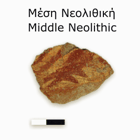 The dating of the site at Paliambela is based on the analysis of the pottery, since dating by absolute methods is still to be carried out. It seems that the main phases of the site correspond to the Middle Neolithic (5800-5200 BC) and Late Neolithic (5200-4500 BC). Comparable sites with similar characteristics are known from Thessaly, such as Sesklo and Dimini, but also from Pieria itself, such as Makrygialos. The dating of the site at Paliambela is based on the analysis of the pottery, since dating by absolute methods is still to be carried out. It seems that the main phases of the site correspond to the Middle Neolithic (5800-5200 BC) and Late Neolithic (5200-4500 BC). Comparable sites with similar characteristics are known from Thessaly, such as Sesklo and Dimini, but also from Pieria itself, such as Makrygialos.
There is also clear evidence for the site extending back into the Early Neolithic (to the end of the seventh millennium), but this needs some further research. In addition, Mycenaean sherds have been found in a series of trenches, but they seem to be related to disturbed graves (13th-12th centuries BC). Finally, traces of later periods (Byzantine and post-Byzantine) are attested in the surface layers in the form of storage and refuse pits, as well as with a number of human burials.
|
| |
| Stratigraphy - Architecture |
 Layers considered to belong to the Early Neolithic have been recognised, by they have not as yet been systematically investigated. Layers considered to belong to the Early Neolithic have been recognised, by they have not as yet been systematically investigated.
The remains of the Middle Neolithic concern a system of ditches and outdoor pebble floors. In the central area, at the top of the hill, the remains of the Late Neolithic have been eroded away, leaving mainly walls, pebble floors and some mud-brick constructions dating to the Middle Neolithic. In the southeastern area and the northern trench parts of ditches have been excavated.
The combination of the data from the excavation and the geophysical survey shows that during the Late Neolithic the site consisted of a system of built stone walls and portions of ditches organised concentrically, between which there were open spaces. Layers dating to the Late Neolithic have mainly been uncovered on the sides of the mound. Parts of a stone perimeter wall have been excavated in the south-eastern area and parts of a ditch in the north-western trench. These constructions were built on layers of the Middle Neolithic, destroying them in parts.
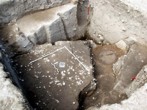 The history of the prehistoric settlement, as has been supposed from the results of the research to date, seems to include some important changes. The site of the Early Neolithic must have covered the whole area of the hill and the modern village, as is attested mainly by the surface finds. The same seems to hold true for the Middle Neolithic, when substantial construction works (ditches) were undertaken. During the Late Neolithic the site seems to have been limited to the area of the hill, and stone perimeter walls were built. During this period the settlement was organised within concentric circular walls that acted both as retaining and demarcating structures. The history of the prehistoric settlement, as has been supposed from the results of the research to date, seems to include some important changes. The site of the Early Neolithic must have covered the whole area of the hill and the modern village, as is attested mainly by the surface finds. The same seems to hold true for the Middle Neolithic, when substantial construction works (ditches) were undertaken. During the Late Neolithic the site seems to have been limited to the area of the hill, and stone perimeter walls were built. During this period the settlement was organised within concentric circular walls that acted both as retaining and demarcating structures.
During Byzantine and Ottoman times the site consists solely of graves and pits located just below the surface layer of the ground. The surface levels of the village dating to the Late Middle Ages - Early Modern years have probably been removed by recent deep ploughing, documented in all the trenches, while the inhabitants of the modern village speak of the removal, a few decades ago, of large quantities of stones from the site to be used as building material. |
| |
| Organisation of the site |
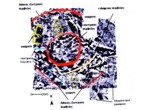 The observations made during the excavation and the related spatial analyses have produced some information concerning the households and the activities carried out in the spaces they occupy, such as storage and food preparation, and lots of information about the pebble floors, which are presently considered to represent the open spaces between the houses. The observations made during the excavation and the related spatial analyses have produced some information concerning the households and the activities carried out in the spaces they occupy, such as storage and food preparation, and lots of information about the pebble floors, which are presently considered to represent the open spaces between the houses.
The detection of structures of household use and their interrelation with the stone or mud-brick walls that divide them from the extensive pebble floors now makes the distinction between open and closed spaces and the appearance of a concentrated household spatial organisation more convincing. On the other hand, the dating of the various structures that have been uncovered suggests that construction, although often repeated in the same space (so as to create in the end a settlement in the form of a low mound), also moved horizontally to a significant degree.
The houses, according to the data the investigation has collected, were constructed on stone foundations with the upper structure built from unbaked mud-bricks; however, temporary, makeshift structures were equally used. It seems that the inhabitants of prehistoric Paliambela expended a lot of effort on building circular features, such as the stone perimeter walls of the Late Neolithic and the deep ditches of the Middle and Early Neolithic, characteristics also attested at flat sites, such as Makrygialos. These finds seem to justify our ambition to better understand the formation mechanisms of Neolithic sites in Central Macedonia.
|
| |
| Material culture |
Pottery
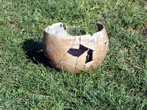 The study of the pottery has already yielded some important information. The pottery of the Middle Neolithic can help in the definition of a local tradition for the MN which until now was based on the best known Thessalian categories. The combination of the Thessalian imported pottery with the local categories at Paliambela is particularly interesting in this respect. The same is true for the NN as concerns the "Dimini" pottery, although the problems that arise in the local sequences are perhaps less pronounced. The study of the pottery has already yielded some important information. The pottery of the Middle Neolithic can help in the definition of a local tradition for the MN which until now was based on the best known Thessalian categories. The combination of the Thessalian imported pottery with the local categories at Paliambela is particularly interesting in this respect. The same is true for the NN as concerns the "Dimini" pottery, although the problems that arise in the local sequences are perhaps less pronounced. 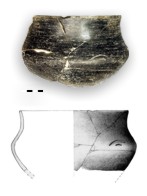 At the same time, the study is producing a range of shapes of the MN and NN which is continually being enriched, while particular importance has been placed on the use of MN pottery as cooking vessels. A series of recent analyses on vessels of the MN from nearby Makrygialos produced a surprisingly rich set of data on the various cooking uses. Selected samples from Paliambela are set to undergo similar analyses. At the same time, the study is producing a range of shapes of the MN and NN which is continually being enriched, while particular importance has been placed on the use of MN pottery as cooking vessels. A series of recent analyses on vessels of the MN from nearby Makrygialos produced a surprisingly rich set of data on the various cooking uses. Selected samples from Paliambela are set to undergo similar analyses.
Moveable finds
 The moveable finds are rich and interesting. Apart from the pottery, the people of the Neolithic site produced figurines and spindle whorls using clay. A number of zoomorphic, and anthropomorphic clay figurines representing male and female forms have been found so far. It is difficult to explain their uses with any certainty, but it seems that these objects are linked to the perceptions and ideas people had of their lives, and of their natural and social environments. On the other hand, the clay spindle whorls are connected to the production of cloth. This is also confirmed by the clay and stone loom weights that have been found during the excavation. The moveable finds are rich and interesting. Apart from the pottery, the people of the Neolithic site produced figurines and spindle whorls using clay. A number of zoomorphic, and anthropomorphic clay figurines representing male and female forms have been found so far. It is difficult to explain their uses with any certainty, but it seems that these objects are linked to the perceptions and ideas people had of their lives, and of their natural and social environments. On the other hand, the clay spindle whorls are connected to the production of cloth. This is also confirmed by the clay and stone loom weights that have been found during the excavation.
In addition, people used tools made from hard stones and bone for various everyday tasks. Numerous tools have been found during the excavation, and an effort is being made to study their distribution in the space and to link this with the various activities of the Neolithic inhabitants. The process of their manufacture is combined with the shaping, negotiation and reproduction of the identity of the inhabitants and with other parameters, such as the existence of non-technical specialisation within the context of the site and the wider area, the methods of tool production, and exchange networks.
 Many pieces of jewellery have been made from bone, such as pendants, bracelets and beads. Similarly, many shells seem to have been used as jewellery, either as pendants or bracelets. An important piece of information is that the majority of bracelets at Paliambela are produced from the Glycimeris species, while in most Neolithic sites bracelets are made from the Spondylus gaederopus species. Finally, two special finds from the excavation are a clay seal and a piece of gold jewellery, which offer rare expressions of individual identity. Many pieces of jewellery have been made from bone, such as pendants, bracelets and beads. Similarly, many shells seem to have been used as jewellery, either as pendants or bracelets. An important piece of information is that the majority of bracelets at Paliambela are produced from the Glycimeris species, while in most Neolithic sites bracelets are made from the Spondylus gaederopus species. Finally, two special finds from the excavation are a clay seal and a piece of gold jewellery, which offer rare expressions of individual identity.
Finally, the analysis of the microfinds (finds smaller than a few millimetres) show beyond any doubt the radical changes between the different layers, differences which of course relate to the specific human agency that created it.
|
| |
| Economy |
 The systematic collection and study of animal bones, burnt seeds and shellfish (shells) reveals that the diet of the inhabitants of the Neolithic settlement was mainly based on the farming economy and stock farming. Wheat, barley, lentils and bitter vetch constituted the staple agricultural crops, while it seems that their diet was supplemented by the collection of some wild species of plants, such as grapes. In addition, the seeds of weeds that have been found in the excavated areas give valuable information about the techniques used to cultivate the land. Many of the techniques that have been recognised (e.g. crop rotation) have common elements with the agricultural practices used until recently in non-mechanised and non-chemical farming. In addition, the inhabitants of the Neolithic site at Paliambela bred domesticated breeds of animals such as cattle, sheep, goats and pigs, mainly for their meat. It is important that their diet was also supplemented by wild breeds, mainly wild boars, roe, deer and wild cattle. Impressively large amounts of shells are being collected during the excavation, a fact that reveals the important contribution they made to the daily diet, as opposed to the consumption of fish which seems to have been exceptionally rare. According to the data collected so far, a wide variety of shells, 35 species, were exploited of which the Cardium glaucum species, which lives in brackish waters and was clearly collected at the mouths of the rivers near the site, makes up 95% of the total amount. The large quantity of this variety, 338 kgr or around 17,000 individuals, indicates their intensive use and the important role they played in the diet of the inhabitants. Traces on the shells show that they were probably eaten raw. The systematic collection and study of animal bones, burnt seeds and shellfish (shells) reveals that the diet of the inhabitants of the Neolithic settlement was mainly based on the farming economy and stock farming. Wheat, barley, lentils and bitter vetch constituted the staple agricultural crops, while it seems that their diet was supplemented by the collection of some wild species of plants, such as grapes. In addition, the seeds of weeds that have been found in the excavated areas give valuable information about the techniques used to cultivate the land. Many of the techniques that have been recognised (e.g. crop rotation) have common elements with the agricultural practices used until recently in non-mechanised and non-chemical farming. In addition, the inhabitants of the Neolithic site at Paliambela bred domesticated breeds of animals such as cattle, sheep, goats and pigs, mainly for their meat. It is important that their diet was also supplemented by wild breeds, mainly wild boars, roe, deer and wild cattle. Impressively large amounts of shells are being collected during the excavation, a fact that reveals the important contribution they made to the daily diet, as opposed to the consumption of fish which seems to have been exceptionally rare. According to the data collected so far, a wide variety of shells, 35 species, were exploited of which the Cardium glaucum species, which lives in brackish waters and was clearly collected at the mouths of the rivers near the site, makes up 95% of the total amount. The large quantity of this variety, 338 kgr or around 17,000 individuals, indicates their intensive use and the important role they played in the diet of the inhabitants. Traces on the shells show that they were probably eaten raw. |
| |
| Palaeoenvironment |
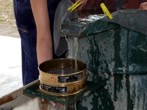 The anthropological study has given evidence for the presence of the following plants at the Neolithic site: Carpinus-Ostrya (hophornbeam), Carpinus orientalis (oriental hornbeam), Cornus sp. (dogwood), Corylus avellana (hazel), Fraxinus sp. (ash), Juniperus sp. (cedar, juniper), Maloideae (the family of the pear, apple, mountain ash, etc.), Monocotyledons, Pinus nigra (black pine), Prunus sp. (the family of the wild cherry, plum, damson, etc.), Quercus deciduous (oak), Quercus sp., Salix sp. (willow), and Ulmus sp. (elm). Thus a number of plant formations have been recognised in the immediate environment of the site, the main one being the Mediterranean forest of deciduous trees, which was made up of various types of oak, hornbeam and ash. The bushy level of these forests included different varieties of Maloideae, while dogwood, hazel and elm took root in wetter locations. The black pine reveals the presence of mixed forests, with this variety and other broad-leafed deciduous plants probably extending throughout Pieria. Bank-side vegetation consisting of willow, hazel and perhaps elm trees grew near the river, which flowed near the Neolithic site. The anthropological study has given evidence for the presence of the following plants at the Neolithic site: Carpinus-Ostrya (hophornbeam), Carpinus orientalis (oriental hornbeam), Cornus sp. (dogwood), Corylus avellana (hazel), Fraxinus sp. (ash), Juniperus sp. (cedar, juniper), Maloideae (the family of the pear, apple, mountain ash, etc.), Monocotyledons, Pinus nigra (black pine), Prunus sp. (the family of the wild cherry, plum, damson, etc.), Quercus deciduous (oak), Quercus sp., Salix sp. (willow), and Ulmus sp. (elm). Thus a number of plant formations have been recognised in the immediate environment of the site, the main one being the Mediterranean forest of deciduous trees, which was made up of various types of oak, hornbeam and ash. The bushy level of these forests included different varieties of Maloideae, while dogwood, hazel and elm took root in wetter locations. The black pine reveals the presence of mixed forests, with this variety and other broad-leafed deciduous plants probably extending throughout Pieria. Bank-side vegetation consisting of willow, hazel and perhaps elm trees grew near the river, which flowed near the Neolithic site. |
| |
| Geomorphology |
 The form of the area in prehistoric times was different given that the sea must have come in closer to the site. The geomorphological studies have shown that the closest streams were fairly active since alluvial phases that seal traces of human activity have been attested. The form of the area in prehistoric times was different given that the sea must have come in closer to the site. The geomorphological studies have shown that the closest streams were fairly active since alluvial phases that seal traces of human activity have been attested.
As regards the site itself, signs of periods of abandonment have been found in various parts of the site. This is also confirmed by the creation of the ancient ground level of the Middle Neolithic at one place on the site, which surely indicates a long abandonment of this particular area during this period. It is clear from the characteristics of the various fills of the Byzantine/post-Byzantine features, as they have been documented by the detailed analyses of the sediments and micro-inclusions, that the historic site differed from the Neolithic as concerns the nature of human activity, the use of building materials, and the type of soil on which the site was founded.
|
| |
| People |
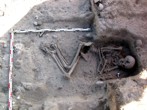 In the case of the site at Paliambela, a number of isolated Neolithic bones have been found, while the triple inhumation of a newborn and two adults also belongs to the Neolithic period, as has been shown by its stratigraphic position, and by its accompanying grave goods. On the other hand, graves belonging to the Byzantine/post-Byzantine period have been found at various points on the mound, while the traces of disturbed Mycenaean graves are also interesting. Since the excavation is still in progress and the anthropological material has not yet been studied, there is no more information about these finds at present. In the case of the site at Paliambela, a number of isolated Neolithic bones have been found, while the triple inhumation of a newborn and two adults also belongs to the Neolithic period, as has been shown by its stratigraphic position, and by its accompanying grave goods. On the other hand, graves belonging to the Byzantine/post-Byzantine period have been found at various points on the mound, while the traces of disturbed Mycenaean graves are also interesting. Since the excavation is still in progress and the anthropological material has not yet been studied, there is no more information about these finds at present. |
|
|





